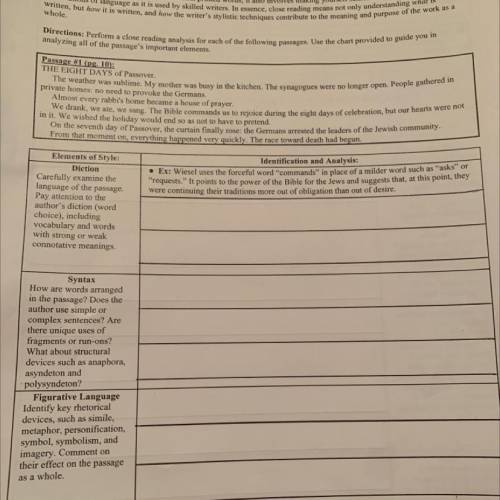
English, 04.10.2021 14:00 gracebuffum
Close Reading: Night
Directions: Perform a close reading analysis for each of the following passages. Use the chart provided to guide you in analyzing all of the passage's important elements.
Passage #1 (px. 10):
THE EIGHT DAYS of Passover
The weather was sublime. My mother was busy in the kitchen. The synagogues were no longer open. People gathered in
private homes: no need to provoke the Germans.
Almost every rabbi's home became a house of prayer.
We drank, we ate, we sang. The Bible commands us to rejoice during the eight days of celebration, but our hearts were not
in it. We wished the holiday would end so as not to have to pretend.
On the seventh day of Passover, the curtain finally rose: the Germans arrested the leaders of the Jewish community.
From that moment on, everything happened very quickly. The race toward death had begun.
Identification and Analysis:
Elements of Style:
Diction
Carefully examine the
language of the passage.
Pay attention to the
author's diction (word
choice), including
vocabulary and words
with strong or weak
connotative meanings.
Syntax
How are words arranged
in the passage? Does the
author use simple or
complex sentences? Are
there unique uses of
fragments or run-ons?
What about structural
devices such as anaphora,
asyndeton and
polysyndeton!
Figurative Language
Identify key rhetorical
devices, such as simile,
metaphor, personification,
symbol, symbolism, and
imagery. Comment on
their effect on the passage
as a whole
Please please please help will mark Brainliest


Answers: 1
Another question on English


English, 22.06.2019 04:50
Read the passage, then answer the question that follows. no one could have seen it at the time, but the invention of beet sugar was not just a challenge to cane. it was a hint—just a glimpse, like a twist that comes about two thirds of the way through a movie—that the end of the age of sugar was in sight. for beet sugar showed that in order to create that perfect sweetness you did not need slaves, you did not need plantations, in fact you did not even need cane. beet sugar was a foreshadowing of what we have today: the age of science, in which sweetness is a product of chemistry, not whips. in 1854 only 11 percent of world sugar production came from beets. by 1899 the percentage had risen to about 65 percent. and beet sugar was just the first challenge to cane. by 1879 chemists discovered saccharine—a laboratory-created substance that is several hundred times sweeter than natural sugar. today the sweeteners used in the foods you eat may come from corn (high-fructose corn syrup), from fruit (fructose), or directly from the lab (for example, aspartame, invented in 1965, or sucralose—splenda—created in 1976). brazil is the land that imported more africans than any other to work on sugar plantations, and in brazil the soil is still perfect for sugar. cane grows in brazil today, but not always for sugar. instead, cane is often used to create ethanol, much as corn farmers in america now convert their harvest into fuel. –sugar changed the world, marc aronson and marina budhos how does this passage support the claim that sugar was tied to the struggle for freedom? it shows that the invention of beet sugar created competition for cane sugar. it shows that technology had a role in changing how we sweeten our foods. it shows that the beet sugar trade provided jobs for formerly enslaved workers. it shows that sweeteners did not need to be the product of sugar plantations and slavery.
Answers: 1

English, 22.06.2019 07:00
5. it was "illegal" to aid and comfort a jew in hitler's germany. but i am sure that, if i had lived in germany during that time, i would have aided and comforted my jewish brothers even though it was illegal. • type of figurative language • meaning of figurative language: effect on tone and mood: effect on audience
Answers: 2

English, 22.06.2019 07:00
Was there a true resolution by the end of the play? what is hamlet’s attitude in the final scene? has he resolved the conflict between thought and action? your answer should be at least 250 words.
Answers: 3
You know the right answer?
Close Reading: Night
Directions: Perform a close reading analysis for each of the following passag...
Questions

English, 11.01.2020 19:31

Mathematics, 11.01.2020 19:31


Biology, 11.01.2020 19:31

Mathematics, 11.01.2020 19:31


English, 11.01.2020 19:31




Mathematics, 11.01.2020 19:31

English, 11.01.2020 19:31






Mathematics, 11.01.2020 19:31

Mathematics, 11.01.2020 19:31



